Apus constellation is located in the southern hemisphere. It is a small constellation that represents the bird of paradise. The name of the constellation is derived from the Greek word apous, which means “footless.” (Birds of paradise were once believed to lack feet.) There are no myths associated with the constellation.
The constellation Apus was created by the Dutch astronomer and cartographer Petrus Plancius based on the observations of Dutch navigators Pieter Dirkszoon Keyser and Frederick de Houtman. It first appeared on a 1598 celestial globe published by Plancius and the cartographer Jodocus Hondius in Amsterdam.
Apus is home to two notable deep sky objects: the globular clusters NGC 6101 and IC 4499. The constellation also contains the faint galaxies IC 4633 and IC 4635, and it hosts the gravitationally lensed Sunburst Arc galaxy, the home of the Godzilla star.
Facts, location and map
Apus is the 67th largest constellation in the sky, occupying an area of 206 square degrees of the far southern sky. It lies in the third quadrant of the southern hemisphere (SQ3) and can be seen from locations between the latitudes +5° and -90°. The neighbouring constellations are Ara, Chamaeleon, Circinus, Musca, Octans, Pavo, and Triangulum Australe.
The constellation name Apus is pronounced /ˈeɪpəs/. In English, the constellation is known as the Bird-of-Paradise. The genitive form of Apus, used in star names, is Apodis (pronunciation: /ˈæpoʊdɪs/). The three-letter abbreviation, adopted by the International Astronomical Union (IAU) in 1922, is Aps.
Apus has two star systems with known exoplanets, HD 131664 (G3V) and HD 134606 (G6IV).
The brightest star in the constellation is Alpha Apodis, with an apparent magnitude of 3.825. The nearest star, HD 128400, lies at a distance of 66.36 light years from Earth. Apus does not have any stars brighter than magnitude 3.00 or located within 10 parsecs (32.6 light years) of Earth.
Apus belongs to the Johann Bayer family of constellations, along with Chamaeleon, Dorado, Grus, Hydrus, Indus, Musca, Pavo, Phoenix, Tucana, and Volans. These constellations were created by the Dutch-Flemish astronomer Petrus Plancius in the late 16th century and depicted in German astronomer Johann Bayer’s celestial atlas Uranometria in 1603.
Apus does not contain any Messier objects. There are no meteor showers associated with the constellation.
Apus contains one formally named star. The star name approved by the International Astronomical Union (IAU) is Karaka (HD 137388).
The best time of the year to see Apus is during the month of July, when the constellation appears higher above the horizon around 9 pm.
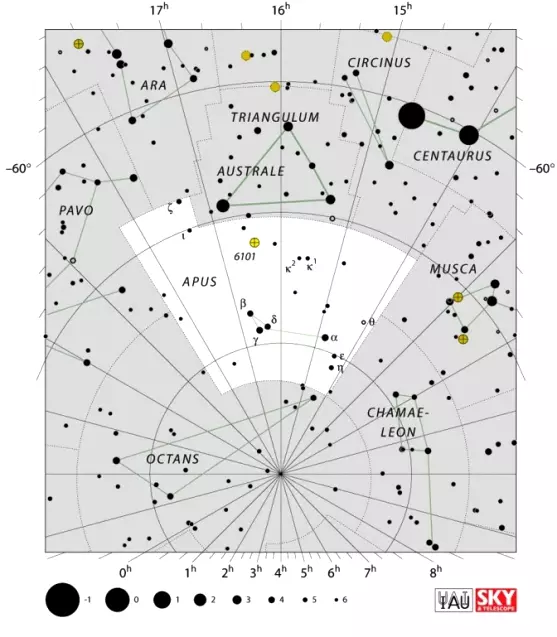
Apus constellation map, by IAU and Sky&Telescope magazine (Roger Sinnott & Rick Fienberg) (CC BY 3.0)
Apus story
Apus is one of the small, faint constellations located in the far southern sky that are largely invisible to observers in the northern hemisphere. The stars of Apus were unknown to European observers before the Age of Discovery, when European navigators started going on expeditions to the southern hemisphere.
Apus is one of 12 constellations that were created based on the observations of Dutch explorers Pieter Dirkszoon Keyser and Frederick de Houtman, who sailed to the East Indies in the late 16th century. Keyser was instructed by Petrus Plancius to map the southern skies. He was aided by de Houtman and Vechter Willemsz. Keyser did not survive the journey, but de Houtman did and brought back his star charts to Plancius.
De Houtman also made astronomical observations on his second expedition, during which he spent two years – from 1599 to 1601 – in captivity in northern Sumatra. These observations supplemented Keyser’s and were later used to adjust the maps on celestial globes.
De Houtman originally called Apus De Paradijs Voghel (Dutch for “the-bird-of-paradise”) in his 1603 star catalogue. Petrus Plancius included it on his globe as Paradysvogel Apis Indica. Apis Indica is Latin for “Indian bee.” Apis, the word for “bee,” was presumably used in error and the constellation should have been named Avis, meaning “bird.”
The constellation was also called Apis Indica in Johann Bayer’s Uranometria, while other astronomers, including Johannes Kepler, referred to it as Avis Indica, “Indian bird.” Kepler called the constellation Apus, Avus Indica in his Rudolphine Tables of 1627. The confusion over the name led to Avis Indica being renamed to Apus. Apis, the Bee, became Musca, the Fly. Both Apis and Avis continued to be used well into the 19th century.
The French astronomer Nicolas Louis de Lacaille called the constellation Apus in his chart of the southern skies published in 1763. Lacaille had used part of the bird’s tail, as well as several stars of Hydrus (the Lesser Water Snake) to create the constellation Octans (the Octant), the home of the south celestial pole.
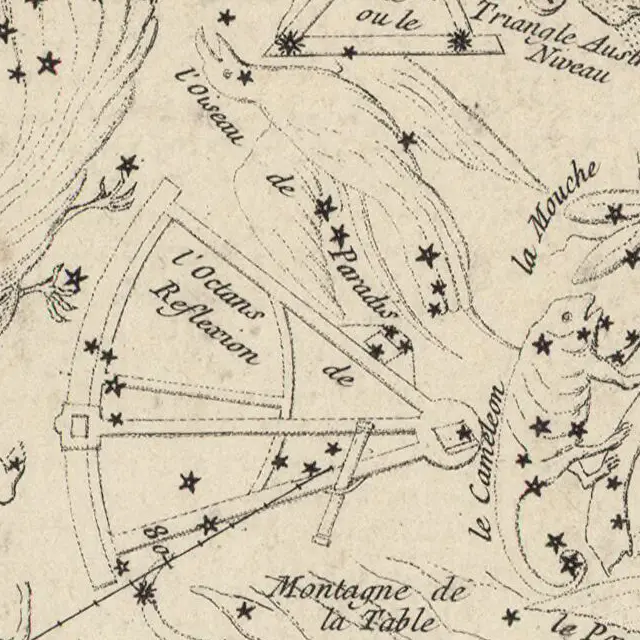
Apus constellation by Nicolas-Louis de Lacaille, 1752 (PD)
Major stars in Apus
Apus contains 39 visible stars (brighter than or equal to magnitude 6.5). It does not have any stars brighter than magnitude 3.0. Alpha Apodis, the constellation’s brightest star, shines at magnitude 3.825 from a distance of 430 light-years. Gamma Apodis is the only other star in the constellation that is brighter than magnitude 4.0, and only four other stars – Beta, Delta, Zeta, and Eta Apodis – are brighter than magnitude 5.0.
The five brightest stars of Apus are all evolved red giants of spectral types K and M. They appear in the region between the bright Triangulum Australe (the Southern Triangle) and the south celestial pole.
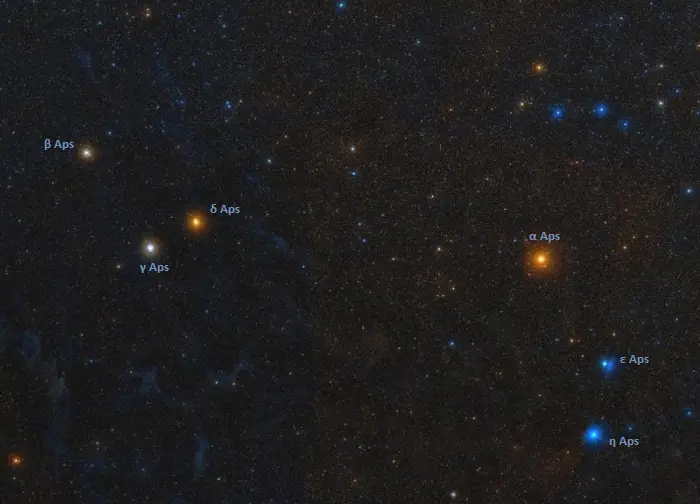
The stars of Apus, image: Wikisky (DSS2)
α Apodis (Alpha Apodis)
Alpha Apodis (α Aps) is an orange giant of the spectral type K2.5III. With an apparent magnitude of 3.825, it is the brightest star in Apus. It lies approximately 430 light-years away.
The evolved star has a mass 4.46 times that of the Sun. As it evolved away from the main sequence, it has expanded to a size of around 65 solar radii. With an effective temperature of around 4,090 K, it shines with 1,072 solar luminosities.
Alpha Apodis is circumpolar for most locations in the southern hemisphere. At declination -79°, it never rises for observers north of the latitude 10° N.
The giant star can be found by extending a line from Alpha Centauri, the third brightest star in the sky, through Alpha Circini in the constellation Circinus (the Compass) in the direction of the south celestial pole.
γ Apodis (Gamma Apodis)
Gamma Apodis (γ Aps) is the second brightest star in Apus. It is a yellow giant star of the spectral type G9 III. It shines at magnitude 3.86 from a distance of 150 light-years. It has a surface temperature of 5,040 K and spins at 2.7 km/s.
The evolved star is one of the 100 strongest stellar X-ray sources within 50 parsecs (163 light-years) of the solar system, along with Diphda in the constellation Cetus, Algol in Perseus, Mu Velorum in Vela, and the bright Capella in Auriga.
β Apodis (Beta Apodis)
Beta Apodis (β Aps) is a K-type giant located 149 light-years away. With an apparent magnitude of 4.24, it is the third brightest star in Apus. Like most other relatively bright stars in Apus, it has exhausted the supply of hydrogen in its core and evolved away from the main sequence.
Beta Apodis has a mass of 1.84 solar masses and a radius 11 times that of the Sun. It has a surface temperature of 4,900 K.
δ Apodis (Delta Apodis)
Delta Apodis (δ Aps) is a Bayer designation shared by two stars. Delta1 Apodis is a red giant of the spectral type M5 IIIb, located 630 light-years away, and Delta2 Apodis is an orange giant with the stellar classification K3 III, located 550 light-years away. The stars are separated by 102.9 arcseconds in the sky. Even though they lie at different distances, they may share a common proper motion.
Even though it is the more distant of the two, Delta1 Apodis is brighter. It has an apparent magnitude that varies between magnitude 4.66 and 4.87. Delta2 Apodis shines at magnitude 5.27. Both stars are visible to the unaided eye in good conditions.
Delta1 Apodis is classified as a semiregular variable star. It pulsates with periods of 68, 94.9, and 101.7 days, which causes variations in its brightness.
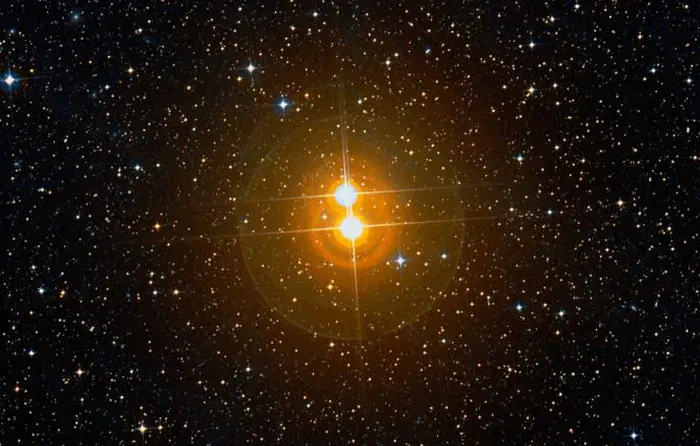
Delta Apodis, image: Wikisky (DSS2)
ζ Apodis (Zeta Apodis)
Zeta Apodis (ζ Aps) is an orange giant of the spectral type K2III, located 293 light-years away. It has an apparent magnitude of 4.78.
Zeta Apodis appears in the same area of the sky as the bright Atria (Alpha Trianguli Australis), the brightest star of the Southern Triangle (Triangulum Australe) and the globular cluster NGC 6362 in the neighbouring constellation Ara (the Altar).
The aging star has expanded to a size of 18.608 solar radii. With an effective temperature of 4,486 K, it is 126 times more luminous than the Sun.
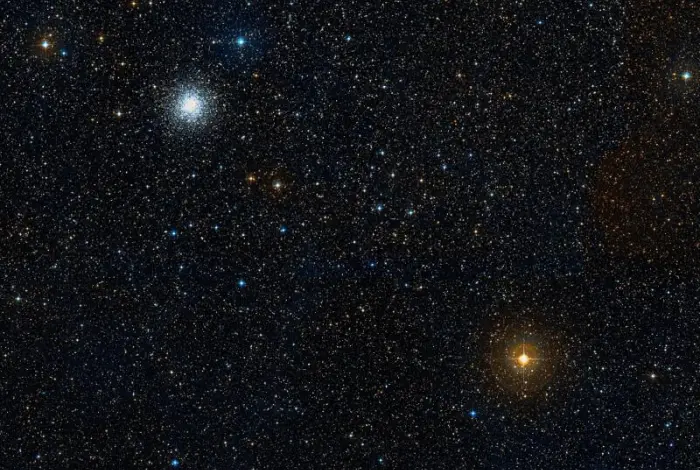
Zeta Apodis and the globular cluster NGC 6362 (2-degree view), image: Wikisky (DSS2)
η Apodis (Eta Apodis)
Eta Apodis (η Aps) is a young A-type star located 140.8 light-years away. It has an apparent magnitude of 4.89.
The star has a mass of 1.77 solar masses and a radius 2.13 times that of the Sun. With an effective temperature of 7,860 K, it is 15.5 times more luminous than the Sun. It has an estimated age of about 250 million years.
Eta Apodis is a chemically peculiar star with an overabundance of chromium and europium. It is classified as an Am star. It shows an infrared excess, indicating the presence of a dusty debris disk at an orbital distance of more than 31 astronomical units (Earth – Sun distances).
In 2023, Eta Apodis was classified as an Alpha2 Canum Venaticorum variable. Named after the prototype Cor Caroli (Alpha2 Canum Venaticorum) in the constellation Canes Venatici, Alpha2 CVn stars are variable stars with strong magnetic fields and prominent lines of silicon, chromium, or chromium. They typically vary in brightness by 0.01 to 0.1 magnitudes with periods of 0.5 to 160 days.
ε Apodis (Epsilon Apodis)
Epsilon Apodis (ε Aps) is a hot blue main sequence star of the spectral type B3 V, located approximately 640 light-years away. It shines at magnitude 5.06 and is faintly visible to the unaided eye in good conditions.
The star has a mass 6.15 times that of the Sun and a radius 3.9 times the Sun’s. With a surface temperature of 17,050 K, it is 1,614 times more luminous than the Sun. It is believed to be only 38.3 million years old.
Epsilon Aps is classified as a Gamma Cassiopeiae variable. Its brightness varies between magnitudes 4.99 and 5.04. Like Gamma Cassiopeiae in the northern constellation Cassiopeia, the star is a fast spinner and has an equatorial disk. It has a projected rotational velocity of 255 km/s. The changes in the shell features cause the irregular variations in brightness.
R Apodis
R Apodis (R Aps) is an orange giant of the spectral type K4 III. It shines at magnitude 5.36 from a distance of 413 light-years. It was the first variable star discovered in Apus.
The star’s variability was discovered by American astronomer Benjamin Apthorp Gould in 1873. Even though it was only a suspected variable, it was given the variable star designation R Apodis. However, various studied in the 20th century, including the photometric data obtained with the Hipparcos satellite, showed that the star had a constant brightness.
R Apodis is older than the Sun, with an estimated age of 5.68 billion years. It has a mass of 1.10 solar masses and a radius 22.9 times that of the Sun. It is 293 times more luminous than the Sun with an effective temperature of 4,318. The evolved giant is a metal deficient star. Its iron abundance is about half that of the Sun.
ι Apodis (Iota Apodis)
Iota Apodis (ι Aps) is a binary star located approximately 1,040 light-years away. It has a combined apparent magnitude of 5.41. The individual components shine at magnitudes 5.90 and 6.46.
The Iota Apodis star system is composed of two hot, blue, massive stars of the spectral types B9 V and B9.5 V. The stars orbit each other with a period of 59.32 years and are separated by 0.115 arc seconds in the sky.
Both stars are more massive than the Sun. Iota Apodis A has a mass of 3.89 solar masses and Iota Apodis B is 3.45 times more massive than the Sun.
κ Apodis (Kappa Apodis)
Kappa Apodis (κ Aps) is a Bayer designation shared by two star systems, Kappa1 Apodis (HR 5730) and Kappa2 Apodis (HR 5782).
Kappa1 Apodis lies 1,060 light-years away and has an apparent magnitude of 5.52, while Kappa2 Apodis shines at magnitude 5.65 from a distance of 780 light-years. The two star systems are not physically related.
Kappa1 Apodis is a spectroscopic binary star composed of a fast spinning Be star and a hot, low-mass subdwarf O star. The two components orbit each other with a period of 192 days. The Be star is classified as a Gamma Cassiopeiae variable. Its brightness has been observed to vary between magnitudes 5.43 and 5.61. It is a runaway star. It has a peculiar velocity of 69.8 km/s.
The primary component has a mass 11.8 times that of the Sun and is 2,120 times more luminous than the Sun. It has a surface temperature of 21,500 K and an estimated age of only 5.6 million years.
The star is a supernova candidate. Even though it is still very young, it will not be long before it burns through its supply of hydrogen fuel and starts fusing helium. It will then continue fusing heavier elements until it develops an iron core, which will collapse and produce a Type II supernova.
The binary companion has a mass of 1.60 solar masses. The spectroscopic pair has a 12th magnitude companion, an orange subgiant, at a separation of 27 seconds of arc.
Kappa2 Apodis is a binary star composed of an evolved blue-white B-type star and an orange K-type main sequence star. The components have the spectral types B7 III-IV and K0 V.
The system has a combined apparent magnitude of 5.65. The brightness comes mostly from the primary component. The companion shines at magnitude 12.5, well below unaided eye visibility. The two stars are separated by 15 arcseconds.
θ Apodis (Theta Apodis)
Theta Apodis (θ Aps) is a red giant star located approximately 350 light-years away. It is classified as a semiregular variable. Its brightness varies between magnitudes 4.65 and 6.20 with a period of 119 days.
Theta Apodis has 2.9 times the Sun’s mass and a radius 208 times the Sun’s. With a surface temperature of 3,131 K, it is 3,748 times more luminous than the Sun.
The pulsating star has a high proper motion and is losing mass at a high rate. The expelled material forms a bow shock 0.134 light-years from the star as θ Apodis moves through the interstellar medium.
Theta Apodis is an astrometric binary. It has an invisible companion whose presence can only be deduced from the primary star’s wobble around a point in space.
S Apodis
S Apodis (S Aps) is a variable carbon star located approximately 15,000 light-years away. With an apparent magnitude that varies between magnitude 9.6 and 17.0, it is well below unaided eye visibility. It is catalogued as HD 133444 in the Henry Draper Catalogue.
S Apodis is a post-AGB star, a luminous intermediate-mass supergiant that has reached a very late stage of its evolution. It has a mass of 0.6 – 1 solar masses and has expanded to a size of 132 solar radii. With an effective temperature of 4,500 – 5,115 K, it is 960 times more luminous than the Sun.
The variability of S Apodis was discovered in 1896. The evolved star was identified as a carbon star by the British-South African astronomer Brian Warner in 1967.
In 1973, S Apodis was classified as an R Coronae Borealis variable. R CrB stars are rare hydrogen-deficient and carbon-rich supergiants that vary in brightness due to low-amplitude pulsations. They occasionally dramatically fade by 1 to 9 magnitudes. These are eruptive variable stars that expel material in the late phase of their lives. As the carbon condenses into soot, it causes the stars to dim in visible light. The stars are believed to be the product of mergers of white dwarfs, stellar remnants that also lack hydrogen.
Karaka (HD 137388)
HD 137388 is an orange star located 132.2 light-years away. With an apparent magnitude of 8.70, it is invisible to the unaided eye. The star has an orbiting planet, HD 137388 b, with a mass of 0.223 Jupiter masses.
HD 137388 has the stellar classification K2IV or K0/K1V, indicating an orange main sequence star or subgiant. The star has 93% of the Sun’s mass and 86% of its radius. It shines with 52.8% of the Sun’s luminosity with an effective temperature of around 5,297 K. The star has an estimated age of 2.991 billion years.
The planet HD 137388 b orbits the host star at a distance of 0.89 astronomical units (AU), inside the star’s habitable zone.
The star was formally named Karaka during the International Astronomical Union’s 2019 NameExoWorlds campaign. The name comes from New Zealand and is the Māori word for the New Zealand karaka tree. The exoplanet HD 137388 b was named Kererū, which is the Māori name for the New Zealand pigeon.
HD 134606
HD 134606 is a yellow subgiant star located 87.44 light-years away. With an apparent magnitude of 6.86, it is below unaided eye visibility. It hosts a system of five orbiting exoplanets.
HD 134606 is slightly larger, more massive and more luminous than the Sun. It has a mass of 1.046 solar masses and a radius of 1.158 solar radii. With an effective temperature of 5,576 K, it shines with 1.161 solar luminosities. The star takes 42 days to complete a rotation. It is older than the Sun, with an estimated age of 7.3 billion years.
The planetary system orbiting HD 134606 was discovered in 2011 using the HARPS instrument (High Accuracy Radial Velocity Planet Searcher) on the European Southern Observatory’s 3.6m telescope at La Silla Observatory in Chile.
In 2024, a team of astronomers detected additional two planets orbiting the star. Four of the planets are low mass and orbiting close to the star and one is a gas giant orbiting in the habitable zone. The scientists found an additional massive substellar companion in the outer portion of the system and a red dwarf companion to HD 134606.
Godzilla
Godzilla is a gravitationally lensed variable star located 10.9 billion light-years from Earth. The star is seen through the gravitational lens PSZ1 G311.65-18.48, a massive galaxy cluster. It was discovered by the Hubble Space Telescope in 2020. At the time of discovery, it was the most luminous star ever observed.
Godzilla is believed to be a luminous blue variable (LBV) undergoing an episode of increased luminosity. Some of the star’s spectral features are similar to those seen in the famous LBV Eta Carinae in the constellation Carina. Eta Carinae underwent a similar outburst in the 19th century, during which its luminosity increased to around 50 million times that of the Sun. The temporary increase in the brightness of Godzilla, combined with the factor of magnification of at least 2000, is what makes the distant star observable by Hubble.
In 2024, a study proposed that Godzilla was not a single star, but a massive young star cluster with thousands of bright members.
Astronomers suspect that a substructure thought to be a dwarf galaxy contributes to the magnification. The substructure was detected by the James Webb Space Telescope (JWST) in 2024. It is not visible in Hubble images.
The Godzilla star is part of the Sunburst Galaxy, a gravitationally lensed galaxy located 10.9 billion light years away. It is one of the several identified stars that lie at great distances, along with Icarus in the constellation Leo, Mothra in Eridanus, and Earendel in Cetus, the most distant star known.
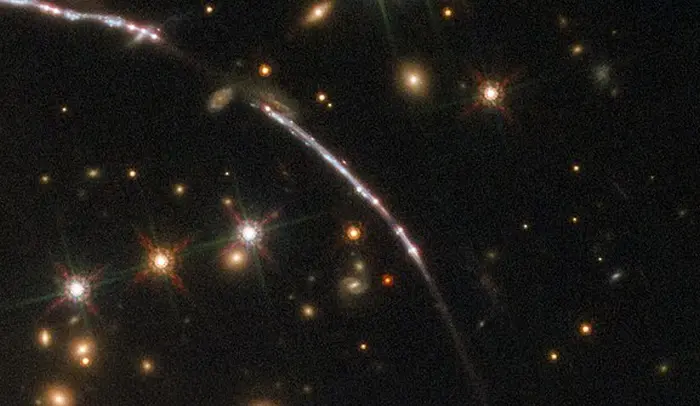
Godzilla is the bright spot at the very center, at the left edge of the arc and immediately above the orange, foreground star. Cropped from original HST image of the Sunburst Galaxy. Credit: NASA, ESA, and E. Rivera-Thorsen (Institute of Theoretical Astrophysics Oslo, Norway) (CC BY 4.0)
Deep sky objects in Apus
Apus does not contain any bright deep sky objects visible in binoculars. It does not host any objects listed in the Messier and Caldwell catalogues. It contains a single object in the Herschel 400 catalogue, the globular cluster NGC 6101.
NGC 6101
NGC 6101 (C107) is a globular cluster located 47,600 light-years from the solar system and 36,500 light-years from the Galactic Centre. With an apparent magnitude of 9, it can be spotted in small telescopes but is best seen in 8-inch and larger telescopes. The cluster has an apparent size of 10.7 arcminutes.
Unlike most globular clusters, which have densely populated cores, the stars of NGC 6101 are more loosely packed. The cluster is also unusual because it does not show mass segregation – heavier stars moving to the centre and lighter members moving away from it – which has led astronomers to believe that NGC 6101 was less dynamically evolved than other globular clusters in the Milky Way.
In 2016, researchers at the University of Surrey in the UK found that the cluster contains as many as several hundred black holes, which was previously believed to be impossible. They deduced the presence of black holes based on their gravitational effect on the surrounding stars. The black holes may account for the absence of mass segregation in the cluster.
The cluster has an estimated age of 12.54 billion years. It was discovered by the Scottish astronomer James Dunlop on June 1, 1826. It appears in the region near the Southern Triangle (Triangulum Australe), less than a third of the way from Alpha Apodis in Apus to the bright Atria in Triangulum Australe.
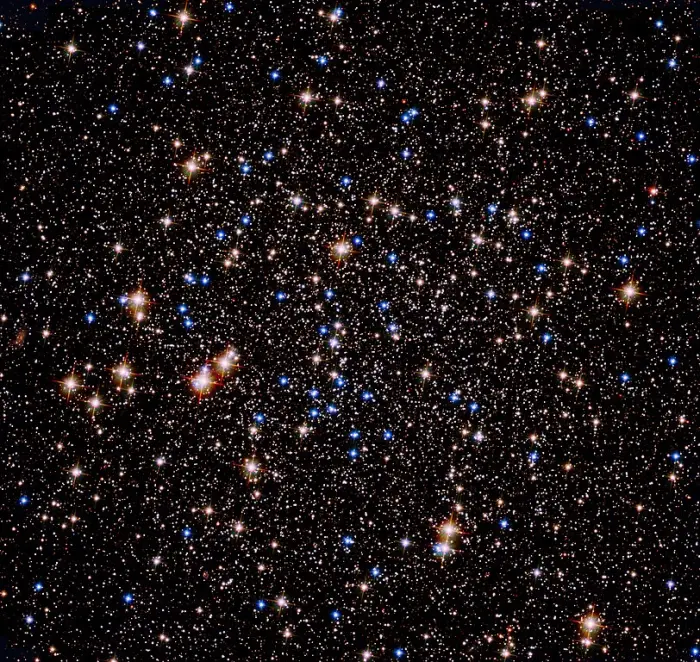
In the past, astronomers thought globular star clusters were made up of stars that have similar ages and similar chemical abundances. However, recent studies suggest that it might not be that simple. It seems as though many globular clusters contain stars with different chemical abundances, suggesting that they host multiple populations of stars born at different times. This image of the globular cluster Caldwell 107, or NGC 6101, combines observations taken in visible, infrared, and ultraviolet light by Hubble’s Wide Field Camera 3 and its Advanced Camera for Surveys. The stars in Caldwell 107 are more loosely packed than those in other globular clusters, which usually have dense, compact cores. Astronomers observed Caldwell 107 with Hubble to study and characterize the multiple populations within the cluster. Caldwell 107 was first observed in 1826 by the Scottish astronomer James Dunlop, who lived in Australia for many years. Astronomer John Herschel, who observed the cluster in the 1830s, described the cluster as being large, faint, round, and only a little brighter in the middle. The cluster is easiest to spot during the winter from the Southern Hemisphere. A mid-sized telescope is needed to resolve some of the cluster’s individual stars. Image credit: NASA, ESA, G. Piotto (Università degli Studi di Padova), and A. Sarajedini (Florida Atlantic University); Processing: Gladys Kober (NASA/Catholic University of America) (CC BY 2.0)
IC 4499
IC 4499 is a globular cluster located 50,000 light-years away in the Milky Way’s halo. The loose cluster is 7.6 arcminutes across and shines at magnitude 9.76. It is the closest globular cluster to the south celestial pole.
The cluster has an estimated age of 12 billion years. Like other old globular clusters, it hosts two generations of stars.
IC 4499 can be spotted in medium-sized telescopes. In 8-inch telescopes, it appears as a small patch. It was discovered by the American astronomer DeLisle Stewart from Harvard College Observatory’s station at Arequipa in Peru in June 1901.
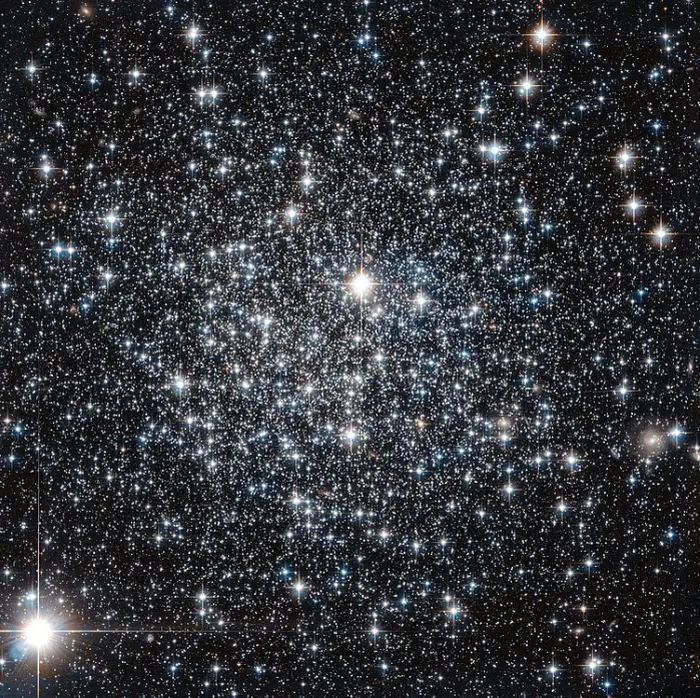
This NASA/ESA Hubble Space Telescope image shows the globular cluster IC 4499. Globular clusters are big balls of old stars that orbit around their host galaxy. It has long been believed that all the stars within a globular cluster form at the about same time, a property which can be used to determine the cluster’s age. For more massive globulars however, detailed observations have shown that this is not entirely true — there is evidence that they instead consist of multiple populations of stars born at different times. One of the driving forces behind this behavior is thought to be gravity: more massive globulars manage to grab more gas and dust, which can then be transformed into new stars. IC 4499 is a somewhat special case. Its mass lies somewhere between low-mass globulars, which show a single generation build-up, and the more complex and massive globulars which can contain more than one generation of stars. Image credit: ESA/NASA/Hubble (CC BY 2.0)
IC 4633
IC 4633 is a relatively faint spiral galaxy with an apparent magnitude of 13.0. It was discovered by DeLisle Stewart on August 17, 1900. The galaxy has an apparent size of 3.1 by 2 arcminutes. It appears close to the galaxy IC 4635 in the sky.
IC 4633 appears 1.7 degrees east of Beta Apodis. Several of the Milky Way’s large integrated flux nebulae – nebulae illuminated by the energy from the integrated flux of all our galaxy’s stars – appear in the same region.
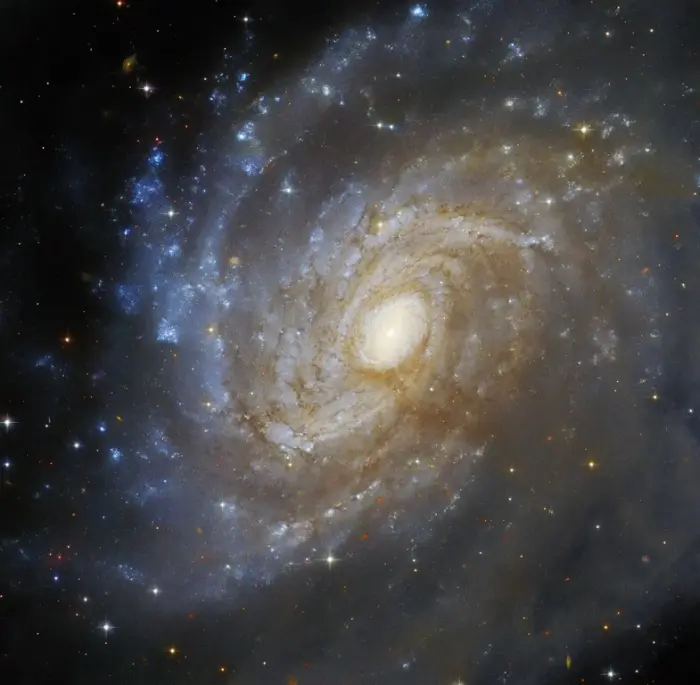
IC 4633 is a galaxy rich in star-forming activity, as well as hosting an active galactic nucleus at its core. From our point of view, the galaxy is tilted mostly towards us, giving astronomers a fairly good view of its billions of stars. However, we can’t fully appreciate the features of this galaxy — at least in visible light — because it’s partially concealed by a stretch of dark dust. This dark nebula is part of the Chamaeleon star-forming region, itself located only around 500 light-years from us, in a nearby part of the Milky Way galaxy. The dark clouds in the Chamaeleon region occupy a large area of the southern sky, covering their namesake constellation but also encroaching on nearby constellations, like Apus. Image credit: ESA/Hubble & NASA, J. Dalcanton, Dark Energy Survey/DOE/FNAL/DECam/CTIO/NOIRLab/NSF/AURA Acknowledgement: L. Shatz (CC BY 4.0)
IC 4635
IC 4635 is a spiral galaxy with an apparent magnitude of 14.0 and an apparent size of 2.51 by 0.6 arcminutes. Like the nearby IC 4633, it was discovered by DeLisle Stewart on August 17, 1900. It appears less than 7 arcminutes east-northeast of IC 4633.
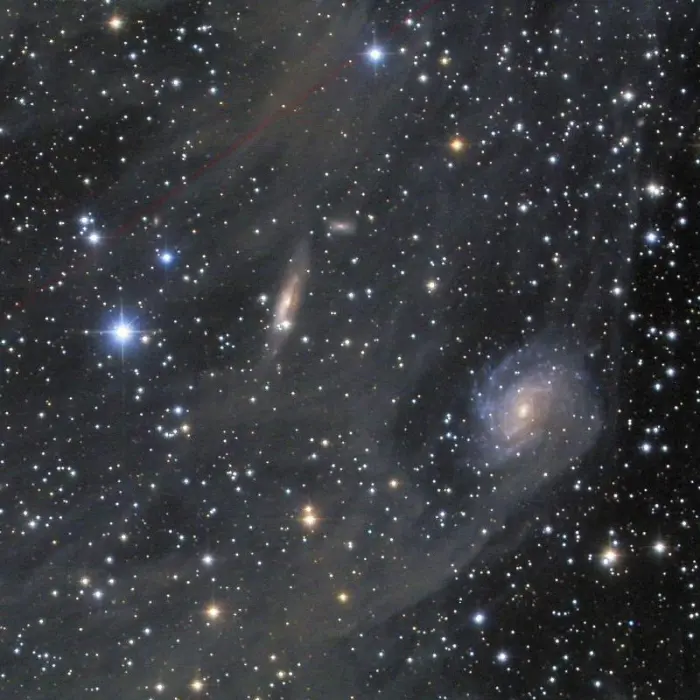
IC 4635 and IC 4633, image: Wikisky
NGC 6392
NGC 6392 is a spiral galaxy located around 175 million light years away. It was discovered by the English astronomer John Herschel on June 17, 1835. It has an apparent magnitude of 11.6 and an angular size of 1.3 by 1.3 arcminutes.
Sunburst Galaxy
The Sunburst Galaxy (or the Sunburst Arc) is a gravitationally lensed galaxy located at a distance of 10.9 billion light-years. The galaxy is strongly magnified by the massive galaxy cluster PSZ1 G311.65-18.48 in the foreground.
The Sunburst Galaxy appears as four arc segments around the lensing cluster. Some of the arc segments are broken up into multiple images. The lensing creates a total of 12 images of the Sunburst Galaxy along the arc. Some of the images are partial while others are full. Some are magnified by large factors. Godzilla, the most luminous star discovered to date, was discovered in one of the strongly magnified images of the galaxy.
In 2023, astronomers identified a massive young star cluster in the galaxy with an estimated age of up to 4 million years. The compact cluster has a mass of tens of millions of Suns packed into a radius of only 10 parsecs (32.6 light-years). It excites the gas in a dense, nitrogen-enriched nebula.
The Sunburst Arc is not to be confused with the Sunrise Arc (WHL0137-zD1), the Cosmic Noon galaxy that hosts Earendel, the most distant star known.
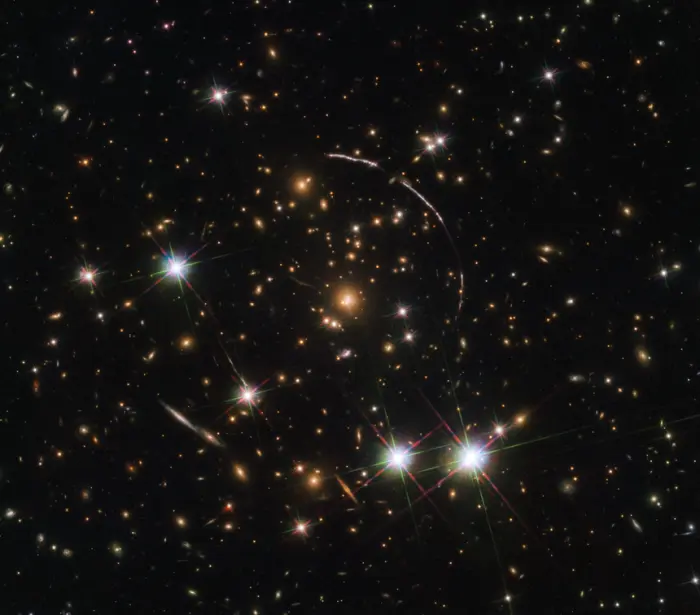
This NASA Hubble Space Telescope photo reveals a cosmic kaleidoscope of a remote galaxy, which has been split into multiple images by an effect called gravitational lensing. Gravitational lensing means that the foreground galaxy cluster is so massive that its gravity distorts the fabric of space-time, bending and magnifying the light from the more distant galaxy behind it. This “funhouse mirror” effect not only stretches the background galaxy image, but also creates multiple images of the same galaxy. The lensing phenomenon produces at least 12 images of the background galaxy, distributed over four major arcs. Three of these arcs are visible in the top right of the image, while one counter arc is visible in the lower left — partially obscured by a bright foreground star within the Milky Way. The galaxy, nicknamed the Sunburst Arc, is almost 11 billion light-years from Earth and has been lensed into multiple images by a massive foreground cluster of galaxies 4.6 billion light-years away.
Hubble uses these cosmic magnifying glasses to study objects that would otherwise be too faint and too small for even its extraordinarily sensitive instruments. The Sunburst Arc is no exception, despite being one of the brightest gravitationally lensed galaxies known. The lens makes images of the Sunburst Arc that are between 10 and 30 times brighter than the background galaxy would normally look. The magnification allows Hubble to view structures as small as 520 light-years across that would be too small to see without the turboboost from the lensing effect. The structures resemble star forming regions in nearby galaxies in the local universe, allowing astronomers to make a detailed study of the remote galaxy and its environment. Image credit: NASA, ESA, and E. Rivera-Thorsen (Institute of Theoretical Astrophysics Oslo, Norway) (CC BY 4.0)
Henize 2-131
Henize 2-131 (Hen 2-131) is a planetary nebula located approximately 7,176 light-years (2,200 parsecs) away. It expands at 11.5 km/s and has an apparent magnitude of 10.47. It appear similar to the better-known Spirograph Nebula in the constellation Lepus (the Hare).
The nebula’s central star is catalogued as HD 138403 in the Henry Draper Catalogue. It is a hot blue star of the spectral type O8(f)ep with a surface temperature of 34,000 K. It may vary in brightness slightly with a period of several hours.
Henize 2-131 was discovered by the British astronomer Andrew David Thackeray in 1950. In 1967, American astronomer Karl Gordon Henize added it to his Catalogues of Hα-emission Stars and Nebulae in the Magellanic Clouds as Hen 2-131.
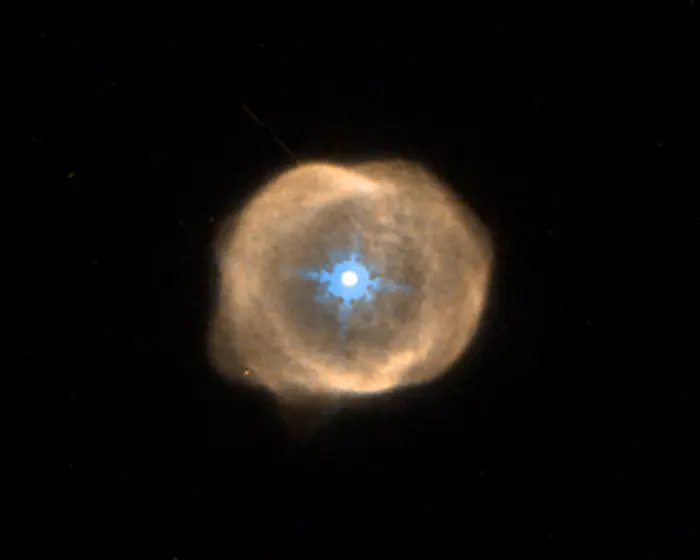
Henize 2-131, based on observations made with the NASA/ESA Hubble Space Telescope, and obtained from the Hubble Legacy Archive, which is a collaboration between the Space Telescope Science Institute (STScI/NASA), the Space Telescope European Coordinating Facility (ST-ECF/ESA) and the Canadian Astronomy Data Centre (CADC/NRC/CSA). (CC BY-SA 3.0)